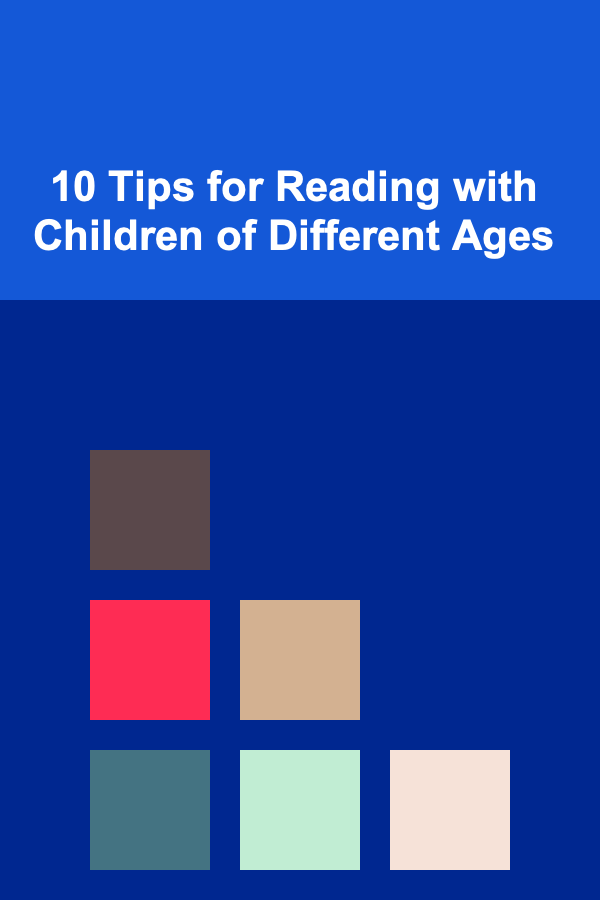
10 Tips for Reading with Children of Different Ages
ebook include PDF & Audio bundle (Micro Guide)
$12.99$10.99
Limited Time Offer! Order within the next:

Reading with children is one of the most valuable activities parents, caregivers, and educators can engage in. It not only supports language development but also fosters emotional growth, cognitive skills, and a lifelong love for books. However, children at different developmental stages have unique needs and preferences when it comes to reading. To ensure that reading is an enjoyable and beneficial experience for both children and adults, it's essential to tailor your approach depending on the child's age.
In this article, we will explore ten tips for reading with children of different ages, from infants to preteens. These tips are designed to help you foster a deeper connection with children through literature while nurturing their literacy development.
Reading with Infants (0-12 months): Start Early with Simple, Engaging Books
While infants cannot understand the words being read to them, early exposure to books is crucial for their development. Infants are highly responsive to sounds, rhythm, and the warmth of a caregiver's voice, and even simple interactions can lay the foundation for language acquisition and a positive attitude toward reading.
Tip: Use Board Books with High-Contrast Images
At this stage, it's best to use sturdy board books with bright, contrasting images and simple text. Babies are attracted to high-contrast visuals, so look for books with bold colors like black and white or red and blue. Books with textured elements, flaps, and mirrors can also capture their attention and encourage interaction.
Reading to infants should be a soothing and engaging experience. Even if your baby is too young to understand the content, narrating the pictures and sounds helps develop their listening skills. Use a slow, clear voice and make eye contact to build a connection. Incorporating songs or rhymes into reading can make the experience even more enjoyable.
Reading with Toddlers (1-3 years): Interactive and Repetitive Stories
As toddlers grow, they begin to recognize familiar words and can follow simple stories. At this stage, their attention spans are short, but they are eager to interact with books in a hands-on way. Toddlers are developing their language skills, so reading together helps reinforce vocabulary and understanding.
Tip: Choose Books with Rhymes and Repetition
Repetitive and rhyming books are especially effective at this stage. Children enjoy the predictability and rhythm, and they quickly learn to anticipate the next word or phrase. Some popular books for toddlers include Brown Bear, Brown Bear, What Do You See? by Bill Martin Jr. and The Very Hungry Caterpillar by Eric Carle.
Books with interactive elements such as textures, lift-the-flap, or touch-and-feel features are also great for engaging toddlers. These types of books encourage tactile exploration, which helps develop fine motor skills and sensory awareness.
Reading with Preschoolers (3-5 years): Introduce Stories with Characters and Simple Plot
Preschoolers are becoming more interested in stories and characters, and they can understand simple plots and ideas. At this age, they are beginning to grasp the connection between written words and spoken language, and they may start to recognize letters and words.
Tip: Focus on Storytelling and Picture Books
Books with simple, yet engaging narratives are perfect for preschoolers. Picture books with captivating illustrations and well-developed characters spark their imaginations. Encourage your child to talk about the pictures and predict what might happen next in the story. This promotes both comprehension and critical thinking skills.
When reading with preschoolers, try to ask open-ended questions like, "What do you think will happen next?" or "How do you think the character feels?" These questions invite your child to think about the story on a deeper level.
Reading with Early Elementary Children (5-7 years): Build Fluency and Encourage Independent Reading
At this stage, children are becoming more confident readers. They can decode words and are able to read simple sentences on their own. However, they still benefit from adult support, particularly with unfamiliar words and more complex storylines.
Tip: Choose Early Readers or Chapter Books
Introduce early readers or chapter books with simple storylines and relatable characters. Books with repetitive phrases and simple vocabulary help reinforce sight words and build fluency. Books like Frog and Toad by Arnold Lobel or Henry and Mudge by Cynthia Rylant are great options for this age group.
While reading together, allow your child to take the lead occasionally. Encourage them to read simple words or sentences aloud to build confidence and fluency. If they struggle with a word, gently prompt them and provide support without taking over the reading experience.
Reading with Upper Elementary Children (7-9 years): Develop Critical Thinking and Comprehension
Children in this age group are beginning to read independently and are capable of understanding more complex stories. Their vocabulary is growing, and they can tackle books with longer sentences and multi-layered plots. Reading continues to support cognitive development, and the stories they enjoy become more sophisticated.
Tip: Introduce Diverse Genres and Themes
Introduce your child to a wider range of genres, including fantasy, adventure, mystery, and historical fiction. Books like Charlotte's Web by E.B. White or The Boxcar Children by Gertrude Chandler Warner are great for this age group. Reading different genres broadens their literary experience and helps them understand different themes and perspectives.
Encourage your child to ask questions about the story and characters. Prompt them to think critically by asking questions like, "Why do you think the character made that choice?" or "What would you do in this situation?" These discussions help develop deeper comprehension skills.
Reading with Tweens (9-12 years): Encourage Independent Reading and Discuss Themes
As children approach the tween years, they are more capable of reading complex texts on their own. They are also beginning to explore more mature themes, and their reading habits are likely to reflect their growing interests and independence.
Tip: Introduce Series and Books with Deeper Themes
At this age, children often enjoy reading series, which provide ongoing characters and plots. Popular series like Harry Potter by J.K. Rowling or Percy Jackson by Rick Riordan can capture the interest of tweens and encourage them to read more. These series offer exciting narratives and more advanced themes, such as friendship, loyalty, and self-discovery.
Reading together is still valuable, especially when discussing the themes and morals of the stories. Ask your child questions that encourage critical thinking, such as, "What did you learn from this book?" or "How do you think the character grew throughout the story?" This helps develop both their reading comprehension and their ability to analyze literature.
Make Reading a Shared Experience Across All Ages
No matter the child's age, one of the best ways to foster a love of reading is to make it a shared experience. Establishing a reading routine helps create positive associations with books and reinforces the importance of reading in daily life.
Tip: Read Aloud Together
Reading aloud, even as children grow older, helps maintain strong connections and enriches their vocabulary. For older children, this can involve reading together from books that are just beyond their independent reading level, offering an opportunity for discussion and vocabulary building.
Try to incorporate reading into family routines, such as reading before bedtime, during quiet afternoons, or even while on a road trip. The act of reading together can strengthen bonds, create meaningful conversations, and enhance learning.
Create a Reading Environment That Encourages Exploration
The physical environment can significantly influence a child's interest in reading. A space that is inviting and comfortable can make reading more enjoyable and help foster a positive attitude toward books.
Tip: Create a Cozy Reading Nook
Create a dedicated reading space in your home that is cozy and inviting. Consider adding soft pillows, blankets, and good lighting. Ensure that the space is filled with a variety of books that cater to your child's interests, so they can explore different genres and topics.
Involving your child in choosing and organizing the books in the reading space can also give them a sense of ownership over their reading materials. When children have easy access to books, they are more likely to engage with them independently.
Model a Love for Reading
Children are more likely to develop a love for reading if they see the adults around them enjoying books. Being a reading role model can have a lasting impact on a child's attitude toward literature.
Tip: Read for Pleasure Yourself
Make time for your own reading and show your child that you value books. Whether it's reading novels, magazines, or even newspapers, children learn by watching their caregivers. Discussing books you are reading can also prompt children to share their own reading experiences, sparking conversations about different genres, authors, and ideas.
Respect Individual Reading Preferences
Every child is different, and their reading interests will vary. While one child might prefer fantasy books, another might be drawn to nonfiction or graphic novels. It's important to respect and encourage their individual preferences rather than impose your choices on them.
Tip: Support Their Interests, Even If They Differ from Yours
Whether your child is into comic books, sports biographies, or adventure novels, make an effort to support their reading interests. The more they enjoy reading, the more likely they will develop a lifelong love for books. Even if the subject matter isn't what you would choose, showing interest and enthusiasm for what excites them will create a positive reading environment.
In conclusion, reading with children is not just about improving literacy---it's about building strong relationships, expanding imaginations, and fostering curiosity. By tailoring your reading approach to suit the age and developmental stage of the child, you can provide them with the tools they need to become confident and passionate readers. By implementing these tips, you can make reading an enriching experience that will last a lifetime.
Reading More From Our Other Websites
- [Home Staging 101] How to Stage a Home for a Rental Property
- [Home Lighting 101] How to Use Nanoleaf Matter for a Stunning Home Theater Experience
- [Organization Tip 101] How to Keep Your Dining Room Decor Minimal and Chic
- [Home Rental Property 101] How to Attract Tenants to Rentals with High-Speed Internet Included
- [Home Party Planning 101] How to Plan a Poolside BBQ Party with a Tropical Twist
- [Home Budget 101] How to Build a Budget for Home Maintenance and Repairs
- [Personal Financial Planning 101] How to Choose the Best High-Yield Savings Accounts Based on Fees, APY, and Accessibility
- [Organization Tip 101] How to Track Your Progress and Achievements Remotely
- [Personal Financial Planning 101] How to Optimize Your Credit Score for Better Rates
- [Home Rental Property 101] How to Protect Your Rental Property from Fraudulent Tenants

How to Make Money Online as a Genealogist: 10 Actionable Ideas
Read More
How to Organize a Wedding Timeline and Day-of Schedule: A Comprehensive Guide
Read More
Navigating the Complexities of Insurance Underwriting: Practical Applications and Case Studies
Read More
How to Track Hidden Retirement Expenses
Read More
10 Tips for Planning a Destination Wedding Abroad
Read More
10 Advanced Sudoku Strategies for Experts
Read MoreOther Products

How to Make Money Online as a Genealogist: 10 Actionable Ideas
Read More
How to Organize a Wedding Timeline and Day-of Schedule: A Comprehensive Guide
Read More
Navigating the Complexities of Insurance Underwriting: Practical Applications and Case Studies
Read More
How to Track Hidden Retirement Expenses
Read More
10 Tips for Planning a Destination Wedding Abroad
Read More